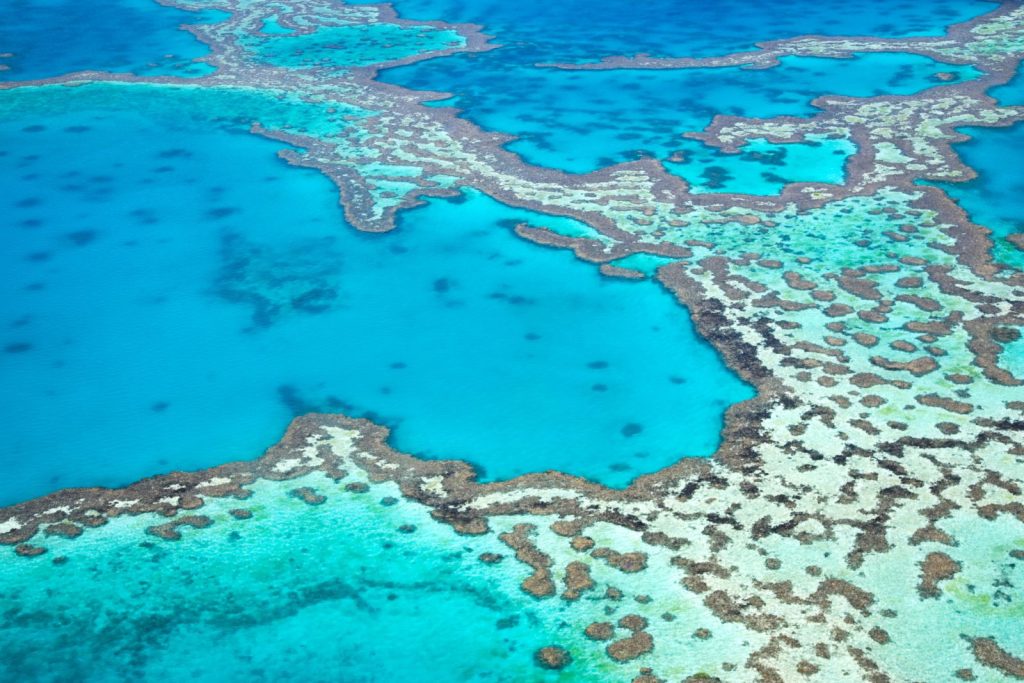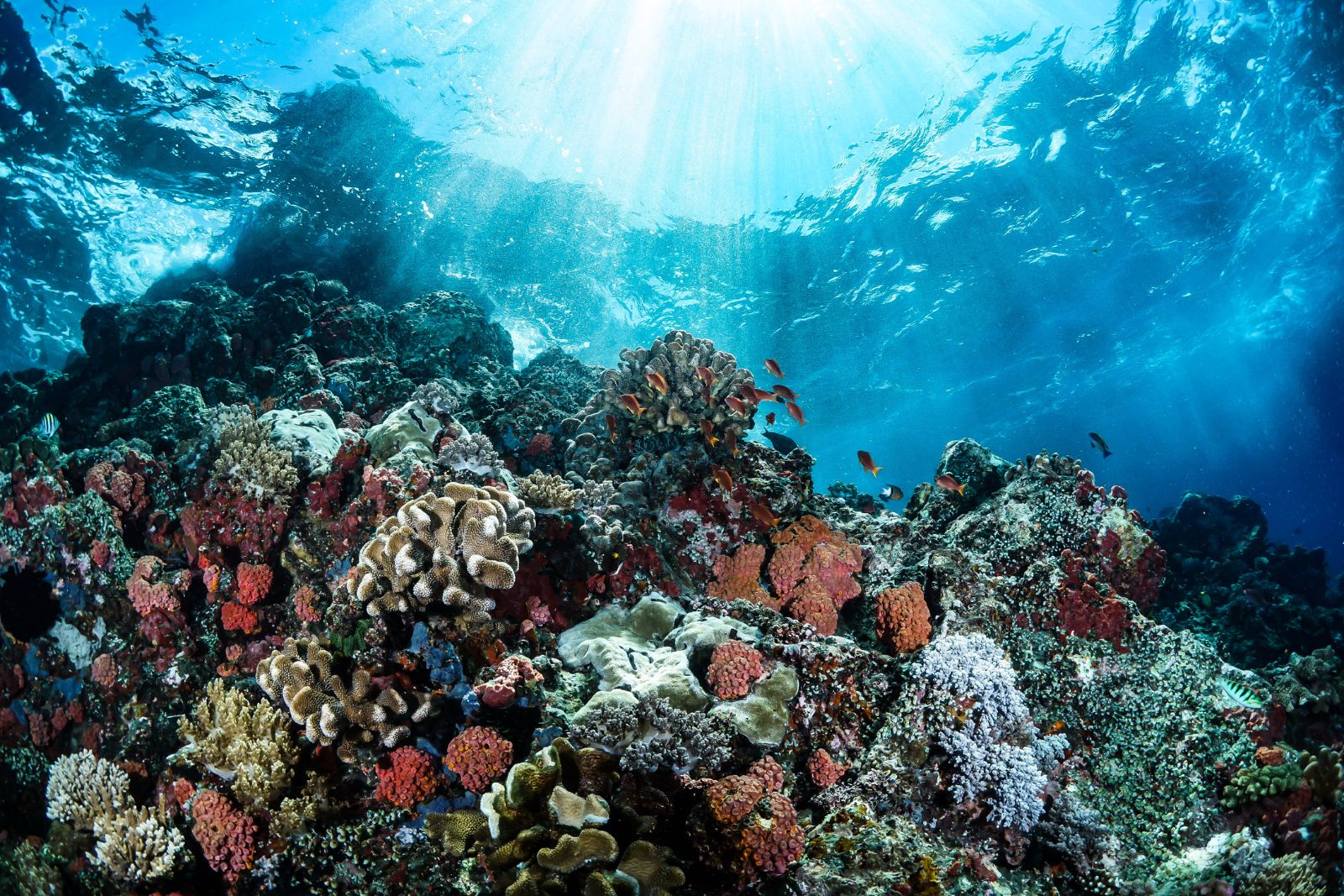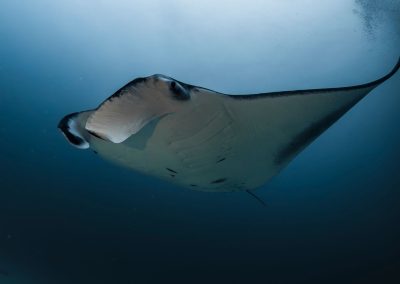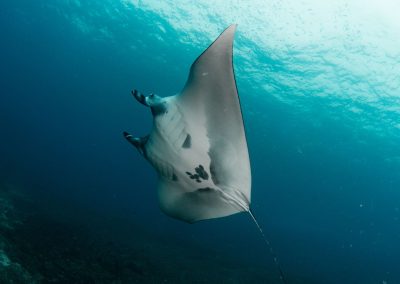Coral reefs are intricate ecosystems that support an incredible range of marine life, including manta rays. We often talk about the importance of protecting manta rays, but many people don’t realize how deeply connected they are to the reefs.
Coral reefs are the primary habitat for reef mantas, but are fragile and face multiple threats. Thankfully, we can all contribute to healthier reefs so that they can keep supporting the gentle giants we love.
About coral reefs
Coral reefs are some of the most diverse and productive ecosystems on Earth. They’re made up of colonies of coral polyps – marine invertebrates that build hard skeletons from calcium carbonate.
Over time, these skeletons accumulate into complex, multi-layered structures that can stretch for hundreds or even thousands of kilometers. For instance, Australia’s Great Barrier Reef is over 1,400 miles long and visible from space.
There are four main types of coral reefs:
- Fringing reefs grow directly from the shoreline, creating shallow lagoons between the reef and the land.
- Barrier reefs are similar, but are separated from land by deeper, wider lagoons.
- Atolls form circular or oval reef structures surrounding central lagoons, typically over submerged volcanic islands.
- Patch reefs are smaller, isolated outcrops of coral that grow in sheltered areas, often within lagoons.

Why reef mantas rely on coral reefs
Coral reefs support a complex system that helps mantas find food, stay healthy, and return to familiar locations.
Reef manta rays are often found in shallow, coastal areas where coral reefs grow. These zones have relatively calm waters, are close to the surface, and make moving between locations like cleaning stations and feeding spots safe.
The structure of the reef itself helps mantas navigate and engage in social behaviors, including courtship and mating.
Also, reef mantas tend to return to the same sites repeatedly, a behavior known as site fidelity. But when coral reefs are damaged, those routines are disrupted; if a cleaning station or feeding ground is lost, mantas may abandon the site entirely.
Coral reefs help mantas feed
Manta rays feed on zooplankton, which in turn feed on phytoplankton. And phytoplankton thrive in places where nutrient-rich water rises to the surface.
Coral reefs help make that happen: they shape local currents and help bring up nutrient-rich water, creating the perfect conditions for phytoplankton to grow. In other words, healthy reefs are the foundation for the whole food chain that mantas rely on.
→ Read more about how manta rays feed
Manta ray spa: cleaning stations
One of the most underrated services coral reefs provide is access to cleaning stations. These are spots on the reef where “cleaner fish” gather to pick parasites, dead skin, and bacteria off larger marine animals like manta rays. Mantas visit these stations regularly and tend to return to the same few sites throughout their lives.
When reefs degrade, the cleaner fish disappear, and manta rays need to search for a new cleaning station; if they can’t find one quickly, their health is at risk.
→ Read more about manta ray cleaning stations
Where this relationship shows up in the wild
Many of the world’s reef manta populations live in places where healthy coral reefs are still hanging on – at least for now.
- Hawai’i: On the Big Island, mantas visit cleaning stations along the Kona coast during the day and feed in plankton-rich waters near the reef at night. The artificial lights used at manta viewing sites attract plankton, creating a reliable food source.
- Maldives: Here, mantas follow seasonal monsoons that attract plankton along the edges of atolls and outer reefs. These patterns draw mantas to specific reef channels year after year.
- Indonesia: Coral reefs in regions like Raja Ampat and Komodo are known for their biodiversity and strong currents. Mantas use these currents to feed and visit cleaning stations along reef structures.
- Mozambique: Along the southern coast, reef mantas find established cleaning stations and food, as the waters are influenced by nutrient-rich upwellings near the Bazaruto Archipelago.
- Australia: The Ningaloo Reef and parts of the Great Barrier Reef host manta populations that rely on nearshore reef habitats for feeding, cleaning, and movement.
→ Find out more about manta ray habitats worldwide
The threats to coral reefs
Coral reefs are some of the most threatened ecosystems on the planet. And when they suffer, so do the animals that depend on them, including reef manta rays. Here’s a breakdown of the biggest threats facing coral reefs today, and why they’re a problem.
Warmer oceans lead to bleached reefs
Corals are very sensitive to heat. When ocean temperatures rise, corals become stressed and expel the tiny algae that live inside them. This leads to coral bleaching, where the reef turns pale and weak. If temperatures don’t return to normal, the corals can die.
Bleached reefs lose their structure and function, meaning fewer cleaning stations, less biodiversity, and disrupted food webs, all of which affect manta rays.
→ Read more about coral bleaching here
Water pollution: too much of a bad thing
Pollution from farms, cities, and coastal development brings too many nutrients into the ocean. That might sound like a good thing, but it fuels algae blooms that smother coral and block sunlight.
In addition, sediment from construction, plastic waste, oil spills, and boat fuel leaks create a messy, unhealthy reef environment.
This kind of pollution can damage coral directly and make it harder for plankton to thrive, which means less food for the gentle giants.
Destructive fishing practices
Many fishing techniques harm coral reefs on a large scale. Blast fishing (using explosives to stun fish) and cyanide fishing (spraying poison to catch live fish for aquariums) destroy coral on contact; cyanide, in particular, is a chemical that stuns fish but also kills coral polyps and harms the surrounding reef.
Even without explosives or poison, overfishing can throw off the reef’s natural balance. Fish species that control algae or act as cleaner fish may disappear, and that’s harmful for manta rays.
My heart hurts writing this, but facing the challenges and harmful practices is crucial. We need to stay in reality to tackle the problems
Unregulated or unsupervised coastal recreation
Snorkelers standing on coral and boats dropping anchors directly onto reefs can physically damage coral or disturb the animals that rely on it. Activities designed to help people appreciate the ocean, like manta ray snorkeling tours, need to be done sustainably and responsibly; this is currently an issue in Hawaii, as manta ray tourism is still completely unregulated, and careless tour operators create damage that can’t easily be repaired.
→ Find out more about the need for manta tourism regulation in Hawaii
Ocean acidification: a hidden threat
As we burn fossil fuels, the ocean absorbs more CO₂, which lowers its pH. This is called ocean acidification, and it makes it harder for corals to build and maintain their skeletons.
We don’t see this damage as quickly as bleaching, but over time, acidification can weaken entire reef systems, threatening both coral survival and the food system that mantas depend on.
Chemicals from sunscreens and related products
Some common sunscreen ingredients, like oxybenzone and octinoxate, are toxic to coral reefs, especially in shallow areas where people swim. These chemicals can cause coral bleaching and disrupt coral reproduction.
→ Learn how to carefully choose your sunscreen here.
Protecting the habitat protects the mantas
Coral reefs and manta rays are deeply connected. When reefs are healthy, mantas thrive. When reefs collapse, mantas abandon those spots, and the entire ecosystem shifts.
That’s why marine protected areas (MPAs) are so important: they limit harmful activities and give reefs a chance to recover.
Local actions matter too: coral restoration, sustainable tourism, and education campaigns can all help keep these underwater worlds thriving.
Protecting coral reefs doesn’t just help the reef itself; it protects the entire web of life around it. If you care about mantas, you have to care about coral reefs. It’s all connected, and it all needs protecting.
How you can help
Even if you live far from coral reefs, your actions can make a difference:
- Choose reef-safe sunscreen when visiting coastal areas (avoid oxybenzone and octinoxate) – read more about this here
- Support marine protected areas and organizations that work on reef conservation
- Reduce your use of plastics and properly dispose of waste to keep it out of the oceans
- When you go diving or snorkeling, maintain proper distance from coral structures (at least 3 feet/1 meter)
- Choose eco-conscious tour operators who follow responsible wildlife guidelines
- Eat sustainably harvested seafood, reduce, or even better, stop its consumption
- Reduce your carbon footprint to help fight climate change
- Share what you’ve learned about the connection between mantas and reefs
The more people understand how coral reefs support magnificent creatures like manta rays, the better chance we have of protecting both for future generations.














0 Comments